Best road bike wheels reviewed and rated: disc and rim wheelsets to supercharge your ride
Our complete guide to what to look for in the best road bike wheels, including the type of rim, the material, and the depth you should go for

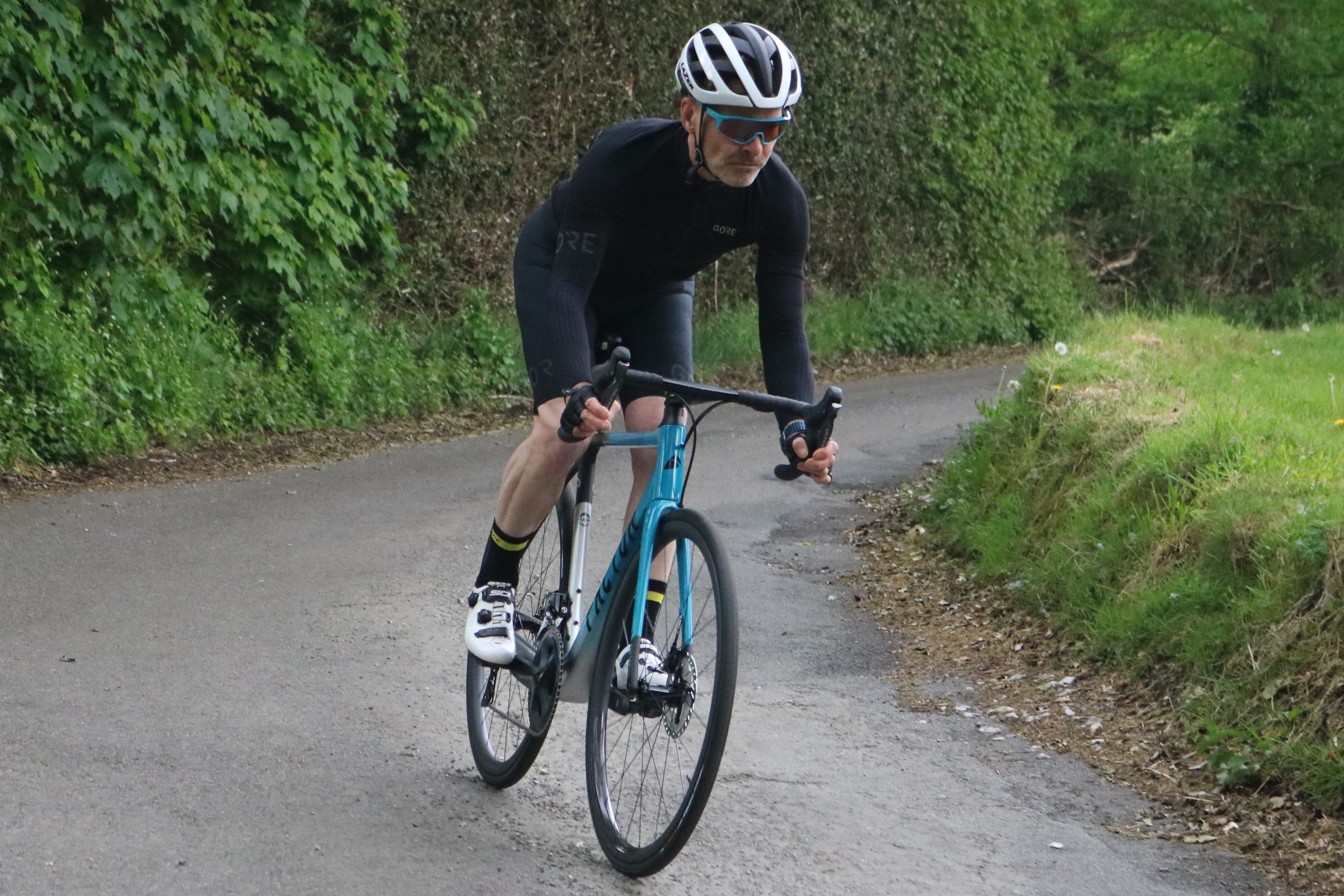
The best road bike wheels are top of most riders' wish lists when it comes to upgrades for their bikes. This is because, more so than most components, a quality set of road wheels can really up the performance of your bike - offering the potential for lighter weight and improved aerodynamics.
Wheels are one area where bike makers often economise to hit a price point and even the best road bikes can come specced with wheels which don't bring out the bike's full potential. It's not such an issue now as it was a few years ago - many brands have upped their game recently and are now now speccing decent wheels - but there's still much to be gained from an upgrade.
The switch to disc brakes has allowed wheel designers to be a lot more creative too, as it removed the constraints on rim width and profile that are inherent in a wheel which has to fit within a rim brake calliper. Deeper section aero wheelsets are now a more attractive proposition.
Having said that, there's still room for a quality set of rim brake wheels and we've covered our pick here too.
Road bike wheels designed for clincher tires (the sort which need inner tubes) are still the main choice for most cyclists. But tubeless tires are rapidly taking over from clincher tires and most new wheelsets are now designed so that they can be run tubeless.
Here, we've concentrated on wheelsets for road bikes, but if you're looking for new wheels for your gravel bike, we've also got a post with a selection of the best gravel bike wheels that we've ridden.
We'll start off with our pick of the best road bike wheels which we've reviewed here at Cycling Weekly. There's a lot to think about when buying a new set of road bike wheels, so further down the page you'll find a detailed guide explaining the choices and technologies to help you make the right choice.
How we test road bike wheels
You can trust Cycling Weekly.
We've ridden hundreds of miles on these wheels in a variety of conditions, both on flat courses and on hillier rides. When a wheelset is tubeless-compatible, we'll have set it up tubeless too and recorded our experiences.
With our crew of highly experienced reviewers we know what to look for in the best road bike wheels.
The best road bike wheels for disc brakes
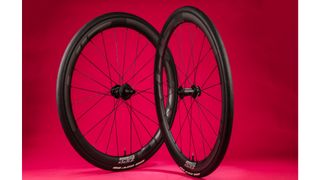
Specifications
Reasons to buy
Reasons to avoid
Zipp's current focus is on producing wheels designed to be run with wide, tubeless tires and at lower pressures. These are hookless rims with a 25mm internal width, so need to be run with rubber over 28mm and below 72psi.
The hookless set up does mean you are slightly limited on the tires which you can use, be we found the ride quality absolutely excellent, with these being one of the best you can currently buy - so we'd very happily accept that slightly narrower choice of tires for the benefits it brings.
The lower tire pressure requirement does deliver a softer ride feel - not to be confused with a slower one. The smoother ride delivers an almost blood like connection with your bike, coupled with the broader rim profile, allows for impressively balanced and confidence inspiring on bike capabilities. In fact, on test, we were able to hit 85km/h and they didn't once so much as give a tiny flutter, even in some gusty wind conditions.
A low rolling weight and a 66 point engagement hub also means these pick up fast and are capable of showing a clean pair of heels in any sprint.
Popping a set of Tangente Course G40 tires gravel tires on the rim the wheels really came into their own. Capable of taking up to 50mm tires and, over a 400km three day adventure, they only lost around 2psi.
Read more: Zipp 303 Firecrest Carbon road bike wheelset full review
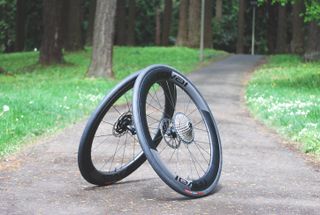
Specifications
Reasons to buy
Reasons to avoid
The latest version II of the Roval Rapide CLX wheels has gone tubeless. It's a mixed depth 51mm front, 60mm rear wheelset, with differing rim widths and profiles. They're designed for tyres between 24mm and 38mm width, but aero optimised for 26mm. At 1,520g they're reasonably lightweight. Hub internals come from DT Swiss, with an EXP freehub and SINC ceramic bearings.
The mixed rim depth is designed to reduce the effect of crosswinds, so we headed off for a windy ride around an island in Oregon, as well as climbing into the mountains, and were impressed with the performance. Equipped with 30mm tyres, they even coped well with gravel.
We've also had a first look at the less pricey Roval Rapide CL II wheels. They lose the ceramic bearings and use slightly less expensive components, but only increase weight by 70g.
Read more: Roval Rapide CLX II road bike wheelset full review

Specifications
Reasons to buy
Reasons to avoid
The Prime Primavera 44 is a great all-rounder tubeless wheelset from Prime’s recently updated range. As the name suggests, these come in at 44mm deep, but there are also 32, 56, and 85mm versions for different balances of aero vs lightness.
For many, the 44mm version will strike the best balance of weight and aerodynamics. The claimed weight is 1,378g - which is very competitive, especially for the price. Our measured weight, albeit with rim tape and tubeless valves, was substantially more at 1,571g - which is more than we’d expect.
Either way, on all but the steeper climbs (>12%), our tester found that the Prime Primavera 44 wheels performed excellently. Thanks to the 24 spokes front and rear, along with the 32t ratchet freehub, the wheels were highly responsive - engaging and accelerating quickly without much in the way of delay or flex.
If you want a wheel that can pretty much do it all, is easy to live with, and promises to be long lasting, these really are a superb option with different depths to suit the sort of riding you want to do.
Read more: Prime Primavera 44 road bike wheelset full review
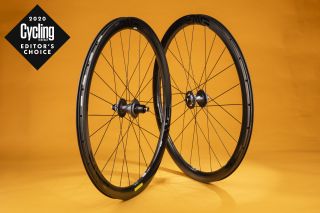
Specifications
Reasons to buy
Reasons to avoid
Enve wheels come at a premium and with their Chris King hubs and overall high-quality build and finish, the SES 3.4 Discs reflect that. They're light at under 1400g and come with the differential rim heights common to all Enve SES wheels - in this case that means a 38mm front wheel paired with a 42mm rear - along with a 21mm internal rim width.
As for the aforementioned hubs, they feature a 45-tooth engagement system, which translates to a quick pick up and minimal drag. You're also getting bearings that are made in-house, all part of a component that's designed to last a lifetime with regular servicing.
The wheels feel very stable and the wide tire stance gives a feeling of control, while they hold their speed well. They may be expensive, but the Enve SES 3.4 wheels may just be the ultimate dream upgrade - especially if you're after a set of wheels that are made in the USA
Read more: Enve SES 3.4 Disc full review
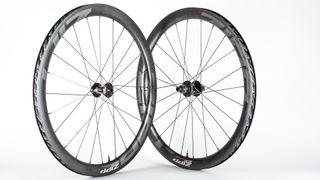
Specifications
Reasons to buy
Reasons to avoid
Zipp wheels are expensive, so the price of Zipp's 303S wheelset is a pleasant surprise. Like Zipp's other latest wheelsets, they have a wide internal rim bed and hookless bead. That lets you run lower pressures, but limits you to compatible tubeless tires of 25mm or wider only and a maximum of 72psi. You also need to look out for tire clearance, if you've got a tight frame.
Zipp says that, aerodynamically, the 303S wheels are almost the match of its much more expensive 303NSW and they feel fast, while the wide contact patch from the 23mm wide rims inspires cornering confidence.
Read more: Zipp 303S road bike wheelset full review
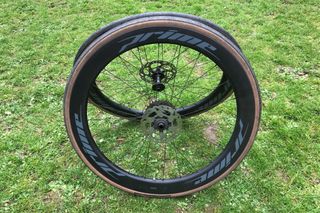
Specifications
Reasons to buy
Reasons to avoid
The Prime Doyenne 56 Carbon Disc Wheelset – previously known as ‘RD56’ – are deep section road wheels to add a bit of aero free speed to any road bike. According to Prime, the wheels are aimed at ‘road riders across all disciplines who prioritise performance, technology and reliability.’ On the whole, the wheels achieve these aims.
We found these wheels to be stiff and responsive – whether accelerating away from traffic lights or trying to power up a short, sharp climb. The aero improvement that you’ll find with almost any deep section wheelset was immediately apparent, they weren’t too sketchy in severe crosswinds either.
Read more: Prime Doyenne 56 Carbon Disc Wheelset full review
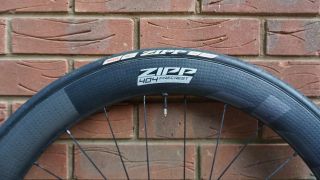
Specifications
Reasons to buy
Reasons to avoid
With a wide 23mm internal width hookless rim, the Zipp 404 Firecrest wheels support 25mm tires well, with a flat-sided profile that helps provide a smooth, aerodynamic interface between the tire and the rim. It also means that you can drop tire pressure for a smoother, faster, more comfortable ride, although it makes the rims tubeless-only.
It also drops the weight of the 58mm deep rim by around 350g to 1,528g and the price from its predecessor. Zipp has also improved the seal design, while the freehub has a low 5 degree engagement angle for fast pickup.
Crosswind stability is good and the Zipps feel fast on the flat, while their weight is low enough for speedy acceleration and climbing.
Read more: Zipp 404 Firecrest road bike wheelset full review
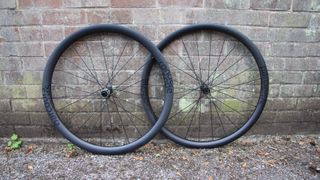
Specifications
Reasons to buy
Reasons to avoid
There's very little not to like about these Parcours wheels. In fact, we gave the Ronde full marks when we reviewed them - for a mid-price wheelset it's got an impressive combination of low weight, great ride quality, aerodynamics and adaptability to road or gravel riding.
There's a differential rim depth and profile front and rear to cope with the different needs - stability at front and power transfer at rear, with the same 23mm internal width for both. Rims are tubeless compatible, although the hooked bead means that they can be used with a wider range of tires than a hookless design.
Parcours wind tunnel tests its wheels and says that although less aero than the deeper Parcours Strade, the Ronde wheels are still best in class for their depth.
Read more: Parcours Ronde wheelset full review
The best road bike wheels for rim brakes
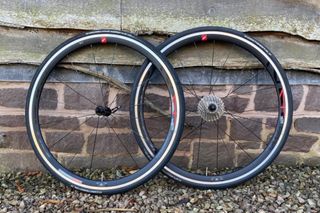
Specifications
Reasons to buy
Reasons to avoid
The Fulcrum Racing 4 C17 is an aluminium rim-brake wheelset which combines a reasonable weight - at 1,727g - with a reasonably deep section 35mm rim for improved aerodynamics.
These wheels do fare very well when it comes to stiffness. Even when setting brake clearance as tight as I dared there was no lateral flex or brake rub when cornering at speed to sprinting out of the saddle maximally. The braking was also brilliant, for rim brakes, and amongst the best I have used, giving greater confidence when descending.
However, the narrow rim width does limit the rolling resistance performance of these wheels significantly compared to other wheels with wider rims that are optimised around chunkier tires. Comparing a pair of 23mm tires on the Fulcrum Racing 4 C17 directly to a set of wheels shod with 27mm tires, the difference in rolling resistance was noticeable - with the total system weight still being close enough as to be unnoticeable .
Value-wise, these wheels are competitively priced against its rivals. Some of the other wheelsets come in at around 100g lighter, however they are mostly 24mm deep and also more expensive. With that weight difference feeling fairly negligible and the aerodynamic gains of a deeper section wheel being more beneficial across most terrains, the Fulcrum Racing 4 C17 do represent a solid choice.
Read more: Fulcrum Racing 4 road wheelset full review

Specifications
Reasons to buy
Reasons to avoid
This performance wheelset is particularly important at what is probably the most competitive price point on the market. They're not the fastest to accelerate because they're 50mm deep, but once the Hunt 50 Carbon Wide Aero wheels are up to speed they're unstoppable and on our tests, these instantly increased our average ride speed.
As ever with Hunt wheels, they're tubeless-ready and have a very wide rim width because of it. Whichever tires you put on it will sit far wider than their stated widths.
Read more: Hunt 50 Carbon Wide Aero full review
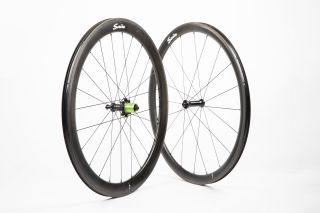
Specifications
Reasons to buy
Reasons to avoid
Scribe has put a lot of thought into creating a wheelset that promises longevity and durability, with plenty of nods to consumer satisfaction - such as customisable bearing options and extra spokes and nipples supplied as standard.
The rims themselves proved to be durable - though their bombproof quality comes at the loss of some compliance. You won't find any flex here, though, so if stiff is on your shopping list then these value for money hoops could be the perfect upgrade for you.
Read more: Scribe 3850 full review
How to choose the best road bike wheels
The thing is, if you want a wheel that is light and aerodynamic, while also being stiff to cope with the power you put out when sprinting, and hardy enough to stay straight and true when faced with rough roads, you’re going to notice a sizeable dent in your bank account. So before buying, it's important to know exactly what you want from your wheelset.

The questions below are a general guide to the things to consider when choosing between the types of wheels that are available, but fortunately for us cyclists most wheels are spread across all three types, and in general it is possible to get a very good set of do-it-all wheels.
How important is durability to you?
If you know you live somewhere with rough roads or mixed terrain then you'll probably put a great emphasis on durability and strength, and having a set of wheels that will stand the test of time. Typically, "bombproof" wheels are shallow, with a box design and an aluminium rim. That doesn't mean they're slow though, and we've been very impressed with box aluminium rims from the likes of Hunt, Mavic and DT Swiss. Similarly, though, that's not to suggest carbon isn't strong, and many pros run carbon wheels at the toughest cobbled classics, but it can offer a harsh ride on rough ground — the pros also aren't paying for or maintaining those wheels.
How important are aerodynamics to you?
If you've just bought yourself a new aero bike, then you'll probably want a wheelset with an aerodynamic edge. These are wheels that have extra material extending down from the rim, which helps the rim cut through the wind. They can give a real advantage if you're racing, or if you want to improve your average speed on your rides. It's worth bearing in mind, though, that to get the most aerodynamic benefits you need to be consistently travelling above 32kph. Of course, if you want a deep section wheel with a carbon build you're going to be spending a fair whack. You can get cheaper, aluminium builds but these tend to be a bit heavier.
How important is a lightweight set of wheels to you?
The lightest wheels are reserved for those who do a lot of climbing or live somewhere very hilly. The weight reduction is possible because of carbon fibre builds, and other neat features like lightweight spokes, carbon fibre hubs and the general removing of any excess material – hence why they tend to have a shallower rim. As you might expect, you'll need deep pockets to buy these lightweight hoops.
Different types of road bike wheels
What are clincher road bike wheels?
Your bike probably came complete with clincher wheels and this is for good reason. Clinchers are the most common type of bike wheel currently available and are defined by the type of tire they use.
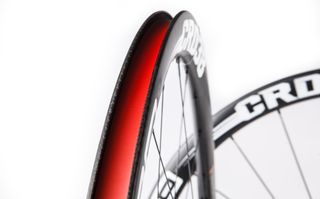
Clinchers utilise an open cross-section tire with a bead that holds it in place on the inside of the rim and uses an inner tube. This offers a great deal of convenience as it is easy to repair when you get punctures.
Carbon clincher wheels are significantly heavier than the equivalent tubulars because the rim needs to be stronger to cope with the demands of braking pressure and force from the rim. Some deep section wheels feature a carbon fairing placed over an aluminium rim. These are heavier, but are cheaper than a complete carbon rim, owing to lower manufacturing and development costs, while the aluminium brake track can lead to more consistent braking with rim brakes than many carbon rims.
What are the pros and cons of clincher wheels?
Advantages of clincher wheels
- Easy to repair punctures, just by carrying spare inner tubes
- Easy to change tires, can be done in minutes
- Clincher tires are typically cheaper than tubulars
Disadvantages of clincher wheels
- Typically heavier than a tubular rim
- Higher rotational weight than a tubular
- Braking surface encounters higher stress, having to withstand outward pressure of the bead and inward pressure of heat from the brakes
What are tubeless road bike wheels?
Tubeless wheels have become very popular over the last few years, with more and more brands fitting them as standard on their bikes. Instead of having an inner tube inside a tire, the tire itself creates an airtight seal against the rim, so all you have to do is inject some sealant and pump some air into the tire.
A consequence of making the rim airtight can be that it is slightly heavier, but this is somewhat offset by the lack of an inner tube. The sealant is designed to seal holes and punctures as they happen. It is still possible to get a flat on a tubeless wheel, at which point an inner tube can be placed inside, but the risk is considerably less, making them ideal for those wanting to avoid punctures. Plus, the general consensus is that these are faster than other types of wheel and tire combinations.
What are the pros and cons of tubeless wheels?
Advantages
- Much lower risk of flat tires
- Low rolling resistance
Disadvantages
- Fiddly to set up
- More weight at the rim
- Generally more expensive
What are hookless tubeless road bike wheels?
The latest type of rim dispenses with the hooks that were originally designed to stop the tire from blowing off. With a hookless rim and compatible tubeless tire there's no need for the hooks anymore. Once the tire moves out of the tire bed cavity that characterises a tubeless rim and up onto the bead 'shelf', it's not going anywhere.
Not all tubeless-ready tires are compatible with all hookless rims yet – that's the only obvious drawback – but according to Zipp that will soon be a non-issue.
What are the pros and cons of hookless tubeless wheels?
Advantages
- No hooks means cleaner transition between the rim and the tire – more aero
- Wider internal rim with no hooks means a more stable tire with no 'lightbulbing'
- Straight rim walls can be made more accurately with tighter tolerances creating a better tire interface and a lower risk of the tire blowing off of the rim
- Better carbon compaction thanks to simpler manufacturing means a stronger rim
- Better resin distribution thanks to simpler manufacturing means the rim can be moulded with less resin – lighter rim
- Less manufacturing waste means a reduction of the costs and a lower price for the end user
Disadvantages
- Not all tubeless tires are compatible with tubeless rims so tire choice is limited
- Risk of tire blowing off rim with the wrong combination or overinflation
What are tubular road bike wheels?
Prior to the invention of clincher tires, tubular wheels were the only option available. Today they’re a rare sight away from racing (where teams have support) as they are an enclosed tire, with an inner tube sealed or sewn inside.
The tubular tire (or "tub") is glued or taped to the rim, making them fiddly to set up very inconvenient if you have to change a tire. Tubular tires are difficult or impossible to repair if you have a flat and a lot more expensive than clinchers.

Tubular wheels are usually lighter than the clincher alternative. This is because the rim does not need to be as strong in order to hold the bead of the tire.
Bonding of the tire to the rim is crucial, in order to avoid rolling the tire off the rim while cornering. Glueing is the most traditional way and considered the most reliable, but it typically takes a couple of days to set, whereas tape is much quicker. The solvent in the glue is also harmful, whereas tape is inert.
If you are racing, riding a sportive or Gran Fondo, or training on a tubular tire and you get a puncture there are a couple of options. Sealant, such as Vittoria Pit Stop can be injected into the tire to seal the hole, but this may not work if the hole is too big.
Alternatively, a spare tub can be placed on the rim, but this will not be bonded as strongly. If you are racing, or riding with a support vehicle, tubulars can be a joy to ride, but for training rides and everyday use, even professionals use clinchers.
What are the pros and cons of tubular tires?
Advantages
- Lighter wheels
- Lighter rim is better for acceleration
- Tubular tires roll very nicely
- Can ride a short distance on a flat tire
Disadvantages
- Less easy to fit than clinchers
- Repairing a puncture is not as straightforward as a clincher
What is the anatomy of a road bike wheel?
Rims
The rims are usually the first thing you notice on a pair of wheels. Deeper section wheels are more aerodynamic, but are generally heavier than their shallow rim counterparts. In addition, crosswinds can catch the deeper section like a sail, which can make keeping the bike in a straight line a handful. A lower profile is much easier to control and is often lighter in weight – meaning it will accelerate faster.
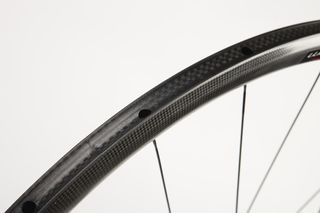
Braking surface
Having a carbon or aluminium wheel is going to directly impact the braking surface of the rim. It is easier to manufacture a perfectly flat braking surface with aluminium and the surface reacts more consistently to braking force from a brake pad, particularly when it's wet, resulting in more consistent braking. In addition, aluminium can be machined to feature grooves and patterns to improve the efficiency of the braking.
Carbon braking is consistently improving as technology moves forward, but still pales in comparison to aluminium, especially in the wet. Carbon braking surfaces can also suffer from heat build, especially if you drag your brakes for a long time, which can lead to de-lamination and failure of the rim.
The move to disc brake wheels removes the need for a braking surface on the rim, meaning that it can be built lighter and with a wider, more aerodynamic profile.
Hubs
Hubs are at the centre of the wheel and contain the axle and bearings. Higher quality hubs are better made, often with superior bearings that roll with less friction. Cartridge bearings are the usual standard on anything except the cheapest wheels because they are simple to replace, although Shimano wheels all use loose ball bearings. The smoothest bearings are ceramic ones, although they come with a price tag to match.
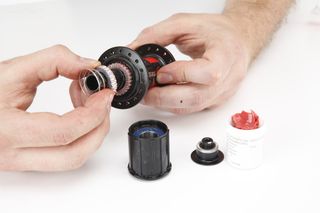
In freewheel bicycles (i.e. anything that is not a fixie), the rear hub has a freehub body which is what holds the cassette. This means you can freewheel without turning the pedals.
Whether a wheelset is Shimano/SRAM 11-speed or Campagnolo 11/12-speed compatible depends upon the freehub body, as the different cassettes have a slightly different pattern in the way they slot onto the freehub. This isn’t usually a problem as different freehub bodies can be purchased and changed on the wheel.
SRAM's 12-speed AXS groupsets utilise an XDR driver, a technology borrowed from its Eagle MTB groupsets to allow for a 10 tooth smallest cog. Shimano has also introduced a new freehub design for its latest 12-speed road groupsets, although they're backward compatible with an 11-speed Shimano freehub body.
Campagnolo has a new freehub body called N3W for its Ekar gravel groupset. Its new wheelsets will come with a compatible freehub, although the good news is that it's compatible with its 11/12-speed cassettes via an adaptor.
Note too that MTB freehubs are not compatible with road bike cassettes, as the freehub body is 1.8mm narrower on MTB wheels.
Do I need a 10, 11 or 12-speed wheelset?
Most new wheels feature a freehub body designed for 11-speed cassettes. But don’t worry if you’re still running 10-speed, as you can use a 10-speed cassette on an 11-speed freehub by using a spacer. These spacers are often included with the wheels, but if you are unsure, check with your local bike shop.
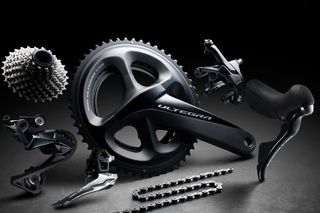
Campagnolo was the first cycling groupset maker to create a 12-speed groupset. The good news is that the cassette fits on the same body as the 11-speed cluster, meaning you should be able to keep using your old wheels. SRAM also now offer a 12-speed road groupset, eTap AXS, but you'll need an XDR driver, while Shimano's 12-speed groupsets are compatible with 11-speed Shimano freehubs.
Spokes and Nipples
Spokes provide support from the hub to the rim and distribute the pressure around the bike wheel, working in both tension and compression. Pay attention to the spoke count, as the more there are the stronger but heavier the wheel. Meanwhile, fewer spokes often make the wheel more aerodynamic. The shape of the spokes also matters, with flat/aero/bladed spokes becoming increasingly standard across all price points.
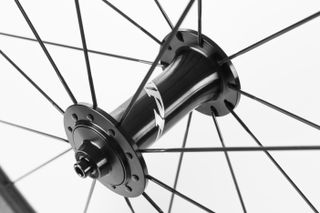
No-nonsense hub with J-bend spokes
Nipples hold the spoke in place on the rim and are typically made of brass. When a wheel is trued the spoke tension is adjusted via the nipple. Aluminium nipples can save weight, although they're more subject to corrosion than brass nipples and can freeze to the spoke or break.
What do all these wheel terms mean?
There's a lot of tech jargon associated with wheels; here's a quick guide to the terms you might come across.
Axle: The wheel's axles come in several different guises. Quick release wheels were the standard for road bike wheels until recently. A lever on a rod can be opened to release a rod that runs through the hollow axle. This allows the wheel to be removed from the open dropout (qv) on the frame and fork.
Quick release wheels are not compatible with thru-axles, which are now more common on disc brake road bikes. These pass through a round hole and screw into the far side of the frame.
You'll also find bolted on wheels on track bikes and most fixed gear bikes.
Axle size: There are multiple standards for axle spacing used on road bikes. Quick release wheels usually run on 100mm wide front axles and either 130mm wide rear axles, which are typically used for rim brake bikes, or 135mm if a bike is designed for QR wheels for disc brakes. The axle is 9mm in diameter.
Wheels and frames for thru-axles usually have 100mm spacing at the front axle and 142mm at the rear, although a few road/gravel bikes use Boost spacing, which is 110mm front, 148mm rear. Thru-axles on road bikes are typically 12mm in diameter.
Dropout: The dropouts are the part of the frame to which the wheel is attached. With quick release wheels, the wheel does literally drop out of the frame when the quick release lever is loosened (although all modern forks have "lawyer's lips" to stop this from happening when not expected.
Thru-axle dropouts are encircled by the frame in most designs, so the wheel doesn't drop out until the thru-axle is removed.
Hub: The hub is the centre of the wheel that rotates around the axle. The hub connects to the rim via spokes, which are connected to the hub flanges. Some hub flanges are designed to use J-bend spokes (qv), while others are straight pull.
Freehub: The freehub is the part of the rear wheel to which the set of gear sprockets is attached. It will have a freewheel mechanism within it. The freehub needs to be compatible with your cassette; there are multiple standards. The freehub width also needs to match your gearing, although you can use spacers to mount a cassette with fewer speeds on a higher spec freehub.
Bearings: The hub turns on the axle via bearings. These may use loose ball bearings, but often cartridge bearings are used. Loose bearings are user-serviceable, whereas cartridge bearings need to be removed and replaced in their entirety when they become worn.
There will be a seal between the hub and the axle to keep out damp and dirt. Cartridge bearings will also be sealed.
Spokes: Spokes connect the hub to the wheel rim. Most are made of steel, but occasionally more expensive wheelsets will use carbon spokes to reduce weight. The spokes thread into the hub.
Usually there's a nipple at the rim end that allows the spokes to be tightened to ensure the wheel's stiffness and that the rim is centred on the hub. Nipples may be brass or aluminium. The former are heavier, but less prone to corrosion.
Spoked may be butted, which means that they are thinner in the middle and wider at their ends, saving weight, or plain gauge, where they have the same diameter along their length. In higher spec wheels, the spokes may be bladed, where the butted central section is shaped to make it more aerodynamic.
Rim: The rim is the outer perimeter of the wheel and is designed to support the tyre. Most rims are designed for clincher tyres, although if you run tubular tyres you'll need a different shaped rim.
Clincher rims subdivide into those designed only to be used with tyres with inner tubes and those that are tubeless-ready. Many rims can be used with both.
There's a further partition of tubeless rims into hooked and hookless designs. Hooked rims can be used with the majority of tubeless tyres, but hookless rims are more fussy, so check your tyres for compatibility if you have hookless wheels.
Higher spec wheels usually have carbon rims, but aluminium alloy is a viable, cheaper alternative. Rims may have their spoke holes centrally positioned across the rim cross-section, but often, particularly for disc brake wheels, the rim profile will be asymmetric. Here, the spoke holes are offset frem the centreline, which allows for more even spoke tension between the two sides of the wheel.
Braking surface: Rim brake wheels will have a braking surface built into the rim, to allow the pads on a rim brake to work. Disc brake wheels are not compatible with rim brakes as they don't have a braking surface on the rim.
The brake disc, or rotor, is attached to the hub in a disc brake wheel and works via a brake calliper attached to the frame near the wheel axle. Most disc brake road bike wheels use the Centerlock standard to attach the disc rotor to the hub, rather than the 6-bolt standard often used for MTB wheels.
Disc brake wheels don't come supplied with a rotor, but will usually have a Centerlock locking ring supplied.
Get The Leadout Newsletter
The latest race content, interviews, features, reviews and expert buying guides, direct to your inbox!
Paul started writing for Cycling Weekly in 2015, covering cycling tech, new bikes and product testing. Since then, he’s reviewed hundreds of bikes and thousands of other pieces of cycling equipment for the magazine and the Cycling Weekly website.
He’s been cycling for a lot longer than that though and his travels by bike have taken him all around Europe and to California. He’s been riding gravel since before gravel bikes existed too, riding a cyclocross bike through the Chilterns and along the South Downs.
-
 Remco Evenepoel goes on first outdoor ride since horror crash, hints at Tour de France on Strava
Remco Evenepoel goes on first outdoor ride since horror crash, hints at Tour de France on Strava'On my way back' says the Belgian, as he builds back up to Tour de France form with almost-100km ride
By James Shrubsall Published
-
 Four weeks after breaking arm, Lizzie Deignan set to start La Vuelta Femenina
Four weeks after breaking arm, Lizzie Deignan set to start La Vuelta FemeninaBritish rider to line up at eight-stage race on Sunday, less than a month on from crash at Tour of Flanders
By Adam Becket Published
-
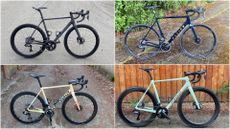 Made in the USA: Four of the best domestic carbon bicycles you should know about
Made in the USA: Four of the best domestic carbon bicycles you should know aboutOffering an alternative to bikes made overseas, these smaller operations are making high-quality carbon bikes closer to home
By Tyler Boucher Last updated
-
 The best bike multi-tools 2024: Function-packed tools for every ride
The best bike multi-tools 2024: Function-packed tools for every rideThe best cycling multi-tools will solve the majority of your on-bike mechanical problems
By Paul Norman Last updated
-
 Best handlebar bags 2024
Best handlebar bags 2024The best handlebar bags will let you carry a good proportion of your bikepacking gear or just your extras for a day ride
By Stefan Abram Last updated
-
 Best bike locks 2024: heavy duty and portable locks for keeping your bike safe
Best bike locks 2024: heavy duty and portable locks for keeping your bike safeYou'll want one of the best bike locks if you plan to leave your bike unattended at any time - here’s what to look for and an overview of some of the best locks on the market
By Simon Smythe Last updated
-
 Best protein-loaded recovery drinks for cycling 2024 rated and reviewed
Best protein-loaded recovery drinks for cycling 2024 rated and reviewedWe look at the best available protein and recovery drinks to ensure you’re recovered and good to go for your next training session
By Andy Turner Last updated
-
 Best cycling vests 2024: extra warmth when you need it
Best cycling vests 2024: extra warmth when you need itCycling vests are one of the most flexible pieces of clothing in your cycling wardrobe. We explain what should you be looking for and round up our favourites.
By Henry Robertshaw Last updated
-
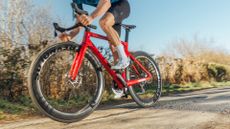 Best aero bikes 2024: fastest speed weapons ridden and rated
Best aero bikes 2024: fastest speed weapons ridden and ratedWe've ridden and rated the best aero bikes and these are our favourites
By Paul Norman Last updated
-
 The best summer cycling clothing for 2017
The best summer cycling clothing for 2017Summer is here so it's time to dress properly for the warmer weather. Our buyer's guide can help you make all the right choices when it comes to summer cycling kit
By Henry Robertshaw Published